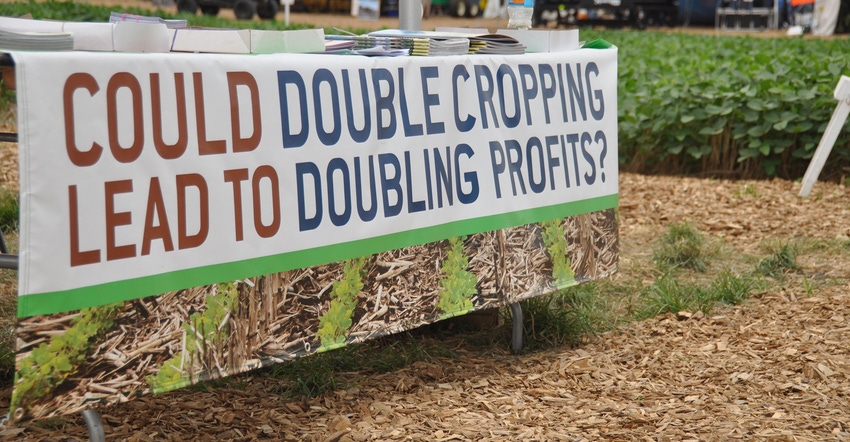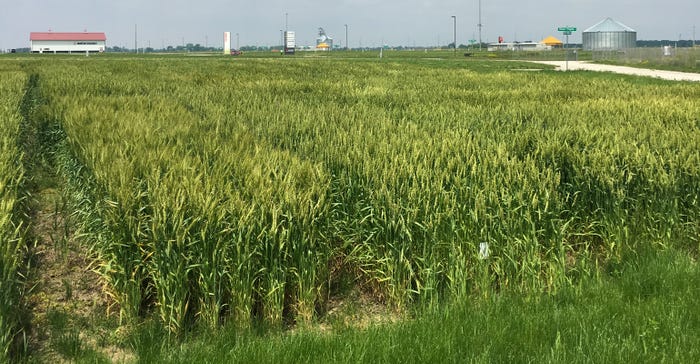
Is it possible to raise double-crop soybeans north of Interstate 80 in Illinois? Dan Davidson, an Illinois Soybean Association technical consultant, believes it’s not only possible, but also profitable to plant double-crop soybeans farther north by using an early-harvest system for wheat. “Farmers have to learn to manage the wheat differently,” he explains. “Then we can push double-cropping further north.”
Eighteen states currently grow double-crop soybeans on a commercial basis, including Kansas, Oklahoma, Maryland and Virginia. Many farmers in southern Illinois already grow wheat as a cash cover crop, Davidson says, but more farmers could benefit from the system.
The Illinois Soybean Association will show farmers how the early-harvest system works with a double-crop soybean demonstration at the 2017 Farm Progress Show.
The early-harvest system works when you plant earlier-maturing wheat varieties that yield comparably to mid- to late-season varieties and are harvested at 20% to 22% moisture, Davidson explains. Harvesting a week earlier could yield a 5-bushel advantage, he adds, and two weeks could mean a 10-bushel advantage.
Limagrain and Syngenta invested in breeding programs to meet market demands for earlier wheat varieties, he says. These new varieties will mature five to seven days earlier and have the same yield potential as late-maturity varieties. And harvesting wetter grain could mean planting soybeans 10 to 14 days earlier, he adds.
“In this sort of system, growers will combine wheat at 18% to 22% and put air on it, rather than heat,” Davidson notes.
Wheat harvested at higher moisture has higher test weights, and farmers avoid complications from vomitoxin. “By taking away docks and test weight challenges, the price goes up,” Davidson says.
He adds that double-cropping soybeans after wheat helps improve soil health and suppresses soybean cyst nematode, one of the most devastating soybean pests.
Plot update
The Illinois Soybean Association’s Farm Progress Show double-crop plot is twice in size this year. The additional space allows John Bailey, the contract ag researcher who tends the double-crop demo plot, to plant replicated trials. He planted eight different wheat varieties in October, which were classified into two maturity groups: early and conventional. The seed was provided courtesy of AgriMaxx, Growmark, Beck’s, Limagrain and Syngenta.

MID-JUNE WHEAT: The wheat stand at the Farm Progress Show double-crop soybean plot looked really good in late May and June, says Jayne Godfrey, Illinois Soybean Association. (Photo: ISA)

Bailey harvested the early-maturity plot in mid-June and planted soybeans five days later. The standard-maturity wheat harvest and soybean planting followed 10 to 12 days later.
When the Farm Progress Show kicks off in late August, farmers will see a significant difference in development between the early-planted and standard soybean plots.
Seed company representatives and double-crop experts will be on hand to answer questions and talk farmers through variety characteristics to consider, such as taller, bushier plants that close the rows more quickly. Davidson hopes the plot will encourage farmers to consider double-cropping soybeans.
“It’s interesting to hear all the disincentives to growing wheat,” he notes. “The early-wheat system can help.”
The ISA double-crop soybean plot is located in the southeast quadrant of the Farm Progress Show site, just off Central Avenue, between Indiana Street and Iowa Street.
About the Author(s)
You May Also Like




